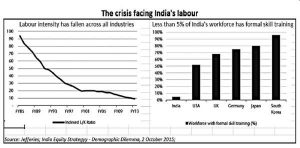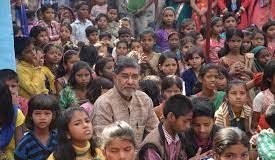http://www.freepressjournal.in/labour-pains-that-threaten-the-government/
Labour pains that threaten the government
— By | Oct 15, 2015 02:53 am
The stakes for the government at the centre are growing higher by each passing month. The spectre of unemployment looms larger with each passing month. Almost 15 months have gone by, but there are few signs that the labour market has revived. Skilling of India’s population is among the lowest among industrial aspirants who seek to be global players (see chart). With more automation reducing the number of jobs across sectors, the need to focus on labour intensive industries becomes more urgent than ever before. Obviously, there is the danger that a restive unemployed youth could become extremely impatient and even violent.
 To appreciate how serious the situation is, it is worth recalling that one reason why Modi came to power was because the previous government did not create enough jobs for the past five years. To remain unemployment neutral, India has to create at least 12 million jobs each year. This is because India has a population of 1.25 billion. Its population grew by 17.64% between 2001 and 2011; or 1.64% annually, down from 2.2% during the ‘70s and the ‘80s.
To appreciate how serious the situation is, it is worth recalling that one reason why Modi came to power was because the previous government did not create enough jobs for the past five years. To remain unemployment neutral, India has to create at least 12 million jobs each year. This is because India has a population of 1.25 billion. Its population grew by 17.64% between 2001 and 2011; or 1.64% annually, down from 2.2% during the ‘70s and the ‘80s.
A 1.67% growth means that 20.5 million people are born each year. This also means that each year at least 20 million people grow from 17 years to 18 years. They need jobs. Even if one discounts the numbers – for girls not seeking employment, opting to be homemakers, or sons of rich parents or business families who don’t seek jobs – India will still have to create 12 million jobs each year to ensure that its people do not become restive and despairing.
The previous government did not create jobs for almost five years. In the last year of its ‘reign’ there was a negative employment growth. Multiply 12 million by five years and you get a backlog of 60 million youngsters seeking employment (not counting the backlog that existed earlier). Each unemployed youth has a father, mother, brother, sister and/or children. Assume an average disaffected core of four people per unemployed person, and you get an agitated population of 240 million people. They became ready fodder that can be easily ignited.
Modi – the current prime minister – assured them jobs. An aspirational population voted him into power with gusto. He could thus form, for the first time in three decades, a government with an absolute majority. Now Modi has to deliver.
The first 15 months haven’t seen much job creation. On the contrary, policies like banning the slaughter of cows and their progeny have actually reduced existing jobs. It also threatens current beef exports of over Rs.30,000 crore. It could affect leather exports as well. Wild schemes are being proposed by some ministers – like setting up meat laboratories at India’s ports to ensure that beef meat does not get exported. They threaten to skew proper allocation of scarce capital resources. Together, they retard incremental job formation.
Ironically, instead of creating financial packages that would prompt states to improve school education (more on this later) the entire focus has been on higher education. Ideology has triumphed over common sense. Instead of producing more (sorely needed) doctors or engineers, the country spends time debating language, culture and history for schools and colleges. The urgent need to skill a population with good basic education and a job skill is shelved.
Given the increase in automation and disruptive technologies, India will have to focus on labour intensive industries – at least for the next decade. They include garments, leather and jewellery which beg for policies that help them revive. And construction.
Happily, Japan could provide the biggest relief to Modi. Its major investment plans – hanging fire since 2003 – could get kickstarted. Work on the dedicated freight corridor (DFC) between Rewari in Haryana to JNPT in Mumbai has resumed. The first phase upto Vadodara should get implemented over the next three years, though the link between Vadodara and Mumbai may get delayed because of all the land acquisition approvals – hence the basic engineering has not been completed.
Work has also begun on the Delhi Mumbai Industrial Corridor (DMC) which should see Japan triggering investments into the first six of the 24 smart cities planned along the DFC. Japan is also working on the Mumbai Ahmedabad corridor and has many other plans which it should be unveiling soon (more on that later).
There are some other silver linings too in an otherwise overcast sky.
Foreign Direct Investment (FDI) inflows have kept increasing, despite a bleak global economic environment. FDI into the manufacturing sector went up from Rs.1.2 trillion in 2012, to Rs.1.3 trillion in 2013, and then jumped to Rs.1.8 trillion in 2014.
During the first 8 months of 2015, FDI has already touched Rs.2.44 trillion (figures compiled by BCG and CII in their report on Manufacturing in India).
Big names have begun trickling in. Last year saw Taiwan’s Foxconn commit itself to investment inflows of US$2.5 billion over the next five years; GM will invest $1 billion for expanding its existing facilities in India; Airbus has promised to account for $2 billion of outsourcing by 2020; while Russian Helicopters has assured India that it will bring in funds worth $700 million. Just recently, Germany’s Angela Merkel promised to bring in Euro 1 billion for the solar sector in India.That is good news for a country gasping for investments to aid job creation.
But these will not create 60 million jobs. India desperately needs policies on labour intensive industries. And provide good school education. And skills.
If Modi does not catalyse these quickly, he might unleash the very same waves of disaffection that unseated the previous regime. This government’s very survival depends on jobs. Social disharmony is the last thing that prospective investors want.





































COMMENTS